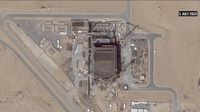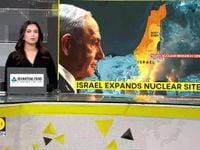Fresh satellite imagery has revealed a flurry of construction activity at Israel’s Shimon Peres Negev Nuclear Research Center, near the desert city of Dimona. This secretive facility, long at the center of speculation about Israel’s nuclear capabilities, is now again thrust into the spotlight, igniting renewed debate about regional security and nuclear proliferation in West Asia.
According to analysis by seven independent experts, the latest images—captured on July 5, 2025, by Planet Labs PBC—show thick concrete retaining walls being installed at a site with multiple underground floors. Towering cranes dominate the landscape, suggesting a major undertaking is underway. The experts, reviewing the images for several international outlets, unanimously agreed that the work is tied to Israel’s nuclear weapons program, given its proximity to the Dimona reactor, which notably lacks any civilian power generation role.
Three of these specialists believe the construction is likely a new heavy water reactor, intended to produce plutonium for atomic bombs. The other four experts suggest it could be a facility for assembling nuclear weapons, highlighting the ambiguity that has always shrouded Israel’s nuclear ambitions. As one analyst put it, “Given the location and the scale of the project, there’s little doubt this is related to Israel’s nuclear arsenal.”
Israel’s nuclear policy has always been one of deliberate opacity. The government neither confirms nor denies possessing nuclear weapons, a stance it has maintained for decades. The United States, Israel’s closest ally, has consistently supported this approach, declining to comment on the new developments. According to multiple reports, both governments refused requests for official statements, adhering to the long-standing policy of silence.
The Dimona facility itself has a storied and controversial history. Built in the late 1950s and early 1960s with French assistance, it quickly became the focal point of international concern. Over the years, it has been widely believed that Israel uses a heavy water reactor at this site to produce plutonium and tritium—the essential ingredients for nuclear weapons. Estimates of Israel’s nuclear arsenal vary, but most experts place the number between 200 and 400 warheads, making it the only country in West Asia known to possess such arms.
Despite persistent calls for transparency, Israel refuses to allow international inspections of its military nuclear facilities. The country also remains one of the few in the world that has not signed the Nuclear Non-Proliferation Treaty (NPT). The United States has consistently backed Israel’s position, even as it presses other nations—most notably Iran—to open their nuclear programs to international scrutiny. This double standard has long been a sore point for critics of Western policy in the region.
Recent events have only heightened tensions. On June 13, 2025, Israel launched what several outlets described as a “blatant and unprovoked act of aggression” against Iran, assassinating a number of high-ranking military commanders, nuclear scientists, and ordinary civilians. Just over a week later, the United States joined the fray, bombing three Iranian nuclear sites. According to reports, these actions were widely condemned as violations of the United Nations Charter, international law, and the NPT itself. The attacks have fueled outrage in Tehran and among non-aligned nations, who see a glaring inconsistency in Western attitudes toward nuclear proliferation.
The latest construction at Dimona comes at a particularly sensitive time. With Iran’s nuclear program under relentless scrutiny and pressure, the revelation that Israel may be expanding or upgrading its own nuclear capabilities is bound to provoke further debate. As one regional analyst noted, “This is going to raise fresh questions about who gets to have nuclear weapons in the Middle East, and who doesn’t.”
Satellite images published on September 4, 2025, have added fuel to the fire. The pictures show a sprawling construction site, with new infrastructure taking shape at a rapid pace. According to the experts, the presence of multiple underground floors and substantial concrete fortifications indicate that the project is both technically sophisticated and intended to be highly secure. The fact that the site is adjacent to the main reactor—rather than in a separate, civilian area—suggests that whatever is being built is central to Israel’s military nuclear program.
For decades, Israel’s nuclear arsenal has been an open secret. The country’s policy of “nuclear ambiguity” has allowed it to avoid both open confrontation and the obligations that come with formal recognition as a nuclear power. This approach has also enabled Israel to avoid the kind of international inspections and verification measures that other nuclear-armed states, such as the United States, Russia, and even India and Pakistan, have accepted in some form. Critics argue that this double standard undermines the credibility of global non-proliferation efforts.
The international response to the new construction has been muted so far, but experts expect that to change as more details emerge. Regional powers, especially Iran, are likely to seize on the revelations to press their case for equal treatment under international law. “If Israel can build new nuclear facilities without oversight, why should Iran be singled out?” asked one Iranian official in a statement to state media. The question is likely to echo in diplomatic circles for months to come.
Meanwhile, ordinary Israelis and their neighbors in the region are left to wonder what the future holds. The prospect of a new reactor or weapons assembly facility at Dimona raises the stakes in an already volatile region. For some, it is a necessary measure of deterrence in a hostile environment. For others, it is a dangerous escalation that could spark a new arms race.
One thing is clear: the veil of secrecy that has long surrounded Israel’s nuclear program is being challenged as never before. With the world watching—and satellite cameras capturing every move—the pressure is mounting for answers. Whether Israel will finally come clean about its nuclear capabilities remains to be seen, but the latest developments at Dimona ensure that the issue will not fade from the headlines any time soon.
In a region where trust is scarce and tensions run high, the construction at Dimona is more than just a building project—it is a symbol of the unresolved questions at the heart of Middle Eastern security. As the world waits for clarity, the debate over Israel’s nuclear future is only just beginning.


